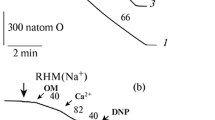Abstract
The aim of the present study was to ascertain whether or not phosphocreatine (PC) could produce electrophysiological and inotropic effects in isolated rabbit cardiac preparations. Exogenous PC (50 mmol/1) was introduced into many cells simultaneously by the “cut-end” and “saponinated-end” methods. PC that entered the cells (opened by cutting or chemical disruption of the sarcolemma) in the loading region, passed through the preparation intercellularly and evoked the following effects in the test region. PC enhanced the spontaneous rate and probably shifted the pacemaker in sinus node strips. On the other hand, PC elevated the action potential amplitude and duration and increased the isometric tension in atrial and ventricular strips. Furthermore, PC applied into ventricular cells partially prevented the effects of hypoxia. These findings suggest that PC may act in cardiac muscle as an intercellular energy carrier. The effects of PC introduced intracellularly resembled these evoked byO-benzyl-phosphocreatine — a permeant synthetic phosphagen - applied via superfusion.
Similar content being viewed by others
References
Bessman SP (1985) The creatine phosphate energy shuttle. Annu Rev Biochem 54:831–862
Breccia A, Fini A, Girotti S, Stagni S (1982) Correlation between physico-chemical parameters of phosphocreatine, ereatine and creatinine, and their reactivity in connection with their potential diffusion in tissues. Pharmatherapeutica 3:227–232
Breccia A, Fini A, Girotti S (1985) Intracellular distribution of double-labelled creatine phosphate in rabbit myocardium. Curr Ther Res Clin Exp 37:1205–1215
Imanaga I (1974) Cell-to-cell diffusion of Procion Yellow in sheep and calf Purkinje fibres. J Membr Biol 16:383–388
Imanaga I (1987) Cell-to-cell coupling studied by diffusional methods in myocardial cells. Experientia 43:1080–1083
Iyengar MR (1984) Creatine phosphate as an intracellular modulator. J Muscle Res Cell Motil 5:527–534
Kakei M, Noma A, Shibasaki T (1985) Properties of adenosine-triphosphate-regulated potassium channels in guinea-pig ventricular cells. J Physiol (Lond) 363:441–462
Kléber AG, Riegger CB, Janse MJ (1987) Electrical uncoupling and increase in extracellular resistance after induction of ischemia in isolated arterially perfused rabbit papillary muscle. Circ Res 61:271–279
Masson-Pévet M, Bleeker WK, Gros D (1979) The plasma membrane of leading pacemaker in the rabbit sinus node. Circ Res 45:621–629
Mc Donald TF, Mac Leod DP (1973) DNP-induced dissipation of ATP in anoxic ventricular muscle. J Physiol (Lond) 229: 583–599
Noma A, Shibasaki T (1988) Intracellular ATP and cardiac membrane currents. In: Narahashi T (ed) Ion channels, vol 1. Plenum, New York, pp 183–208
Page E (1978) Quantitative ultrastructural analysis in cardiac membrane physiology. Am J Physiol 235:C147-Cl58
Rosenshtraukh LV, Witt RC, Nance PN, Rozanski GJ (1990) Electrophysiologic effects of exogenous phosphocreatine in cardiac tissue: potential antiarrhythmic actions. Am Heart J 120: 1111–1119
Saks VA, Strumia E (1993) Phosphocreatine: molecular and cellular aspects of the mechanism of cardioprotective action. Curr Ther Res Clin Exp 53:569–598
Sugiura H, Toyama J, Tsuboi N, Kamiya K, Kodama I (1990) ATP directly affects junctional conductance between paired ventricular myocytes isolated from guinea pig heart. Circ Res 66: 1095–1102
Taniguchi J, Noma A, Irisawa H (1983) Modification of the cardiac action potential by intracellular injection of adenosine triphosphate and related substances in guinea pig single ventricular cells. Circ Res 53:131–139
Trautwein W, Kameyama M (1987) The mechanism of adrenergic regulation of calcium channels: intracellular injections and patch-clamp studies. In: Noble D, Powell T (eds) Electrophysiology of single cardiac cells. Academic, London, pp 105–123
Tuganowski W (1994) Electrophysiologic and inotropic effectsO-benzyl-phospho-creatine in rabbit myocardium. Naunyn Schmiedebergs Arch Pharmacol 350:310–314
Wallimann T, Wyss M, Brdiczka D, Nicolay K, Eppenberger HM (1992) Intracellular compartmentation, structure and function of creatine kinase isoenzymes in tissues with high and fluctuating energy demands: the “phosphocreatine circuit” for cellular energy homeostasis. Biochem J 281:21–40
Weingart R (1974) The permeability of tetraethylammonium ions of the surface membrane and the intercalated disks of sheep and calf myocardium. J Physiol (Lond) 240:741–762
Wojtczak J (1979) Contractures and increase in internal longitudinal resistance of cow ventricular muscle induced by hypoxia. Circ Res 44:88–95
Author information
Authors and Affiliations
Rights and permissions
About this article
Cite this article
Tuganowski, W. The effects of phosphocreatine introduced simultaneously into many cardiac cells. Pflugers Arch. 431, 652–657 (1996). https://doi.org/10.1007/BF02191916
Received:
Revised:
Accepted:
Issue Date:
DOI: https://doi.org/10.1007/BF02191916



